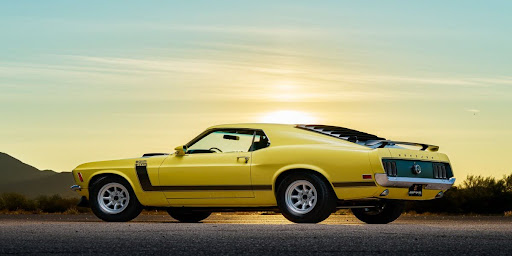Business
The Technological Marvels of Classic Car Models

Classic cars hold a special place in the hearts of automotive enthusiasts worldwide. These timeless marvels not only embody the essence of a bygone era but also showcase the remarkable technological innovations of their time. In this article, we delve into the intricacies of classic car models’ technology, exploring the features and advancements that define these iconic vehicles. Here provided more info.
Design and Engineering
Classic car models are renowned for their exquisite design and engineering brilliance. From the graceful curves of a 1957 Chevrolet Bel Air to the sleek lines of a 1969 Ford Mustang, each vehicle is a masterpiece of its era. These cars often feature handcrafted bodywork, meticulously designed interiors, and attention to detail that reflects the craftsmanship of a bygone era. Furthermore, classic car manufacturers employed innovative engineering techniques to optimize performance and durability, setting the stage for future automotive advancements.
Engine Technology
At the heart of every classic car lies its engine – a testament to the technological prowess of its time. From the thunderous roar of a V8 engine to the smooth purr of a straight-six, classic cars boast a diverse array of powertrains. These engines were often carbureted, relying on mechanical fuel delivery systems to mix air and fuel for combustion. Additionally, advancements in engine technology, such as overhead valve designs and high-performance camshafts, contributed to increased power output and improved efficiency.
Transmission Systems
Classic car models feature a variety of transmission systems, ranging from manual gearboxes to automatic transmissions. Manual transmissions, characterized by their tactile feel and precise gear changes, were the norm during the golden age of automotive design. Conversely, automatic transmissions offered a more relaxed driving experience, allowing drivers to shift gears effortlessly. Both systems played a crucial role in shaping the driving dynamics and performance characteristics of classic cars.
Suspension and Handling
The suspension systems of classic car models were designed to provide a balance between comfort and handling prowess. Leaf springs, coil springs, and torsion bars were commonly utilized to absorb road imperfections and maintain stability during cornering. Furthermore, advancements in suspension geometry and damping technology enhanced the driving experience, allowing drivers to navigate twisty roads with confidence. Classic cars are celebrated for their responsive handling and precise steering, characteristics that continue to captivate enthusiasts to this day. Explore more on this website.
Electrical Systems
Classic car electrical systems represent a fascinating blend of simplicity and ingenuity. Unlike modern vehicles equipped with complex electronic control units, classic cars relied on mechanical switches, relays, and wiring harnesses to power essential components. From ignition systems to lighting fixtures, these electrical systems were designed to withstand the rigors of daily driving while providing reliable performance. Moreover, the simplicity of classic car electrical systems makes them accessible to enthusiasts who enjoy tinkering and restoring vintage vehicles.
Safety Features
While classic car models may lack the advanced safety features found in modern vehicles, manufacturers implemented innovative solutions to enhance occupant protection. Rigid body structures, reinforced chassis, and safety glass were employed to mitigate the effects of collisions and improve crashworthiness. Additionally, advancements in braking technology, such as hydraulic drum brakes and later disc brakes, contributed to shorter stopping distances and enhanced driver control. While classic cars may not meet contemporary safety standards, they remain cherished symbols of automotive history and innovation.
Fuel Systems
Classic car models often featured traditional fuel systems that relied on carburetors for mixing air and fuel before combustion. Carburetors were a staple of automotive technology until the late 20th century when fuel injection systems began to gain prominence. Despite their simplicity, carburetors required periodic adjustments and tuning to maintain optimal performance. However, their mechanical nature provided enthusiasts with opportunities for customization and fine-tuning to achieve desired power outputs and fuel efficiency.
Cooling Systems
Efficient cooling systems were essential for ensuring the longevity and performance of classic car engines. These systems typically comprised a radiator, water pump, thermostat, and coolant, working together to regulate engine temperature. While early classic cars utilized air-cooled designs, liquid cooling systems became prevalent as engines grew larger and more powerful. Innovative radiator designs, such as honeycomb and tube-and-fin configurations, enhanced heat dissipation, allowing engines to operate within optimal temperature ranges even under strenuous conditions.
Interior Comfort and Convenience
Classic car interiors were designed with a focus on comfort and style, featuring luxurious upholstery, ergonomic controls, and thoughtful amenities. Bench seats, adorned with plush fabrics or supple leather, provided ample space for occupants to relax during long journeys. Additionally, manufacturers incorporated innovative features such as air conditioning, power windows, and premium sound systems to enhance the driving experience. While not as advanced as modern infotainment systems, these amenities represented cutting-edge technology at the time and contributed to the allure of classic cars.
Conclusion
Classic car models represent more than mere modes of transportation – they are timeless works of art imbued with technological ingenuity and historical significance. From their exquisite design and engineering prowess to their innovative features and driving dynamics, classic cars continue to captivate enthusiasts and collectors worldwide. As we celebrate these iconic vehicles, let us not only admire their beauty but also appreciate the remarkable technological advancements that have shaped automotive history.





















